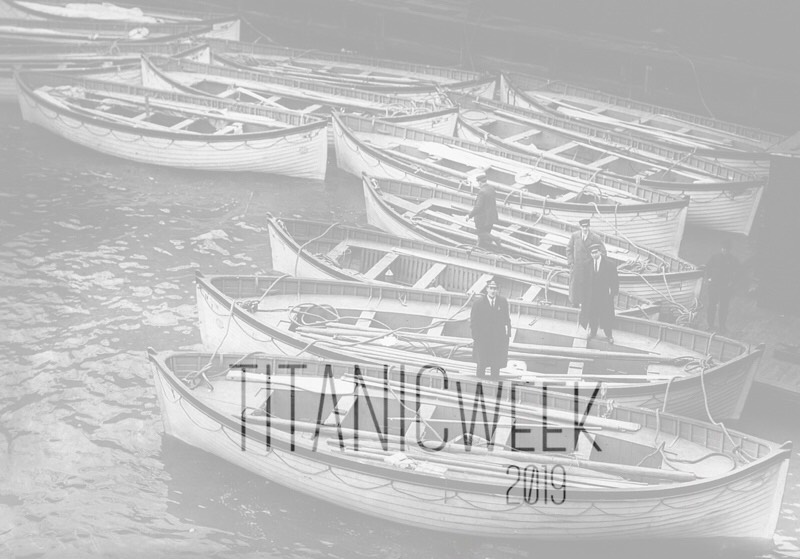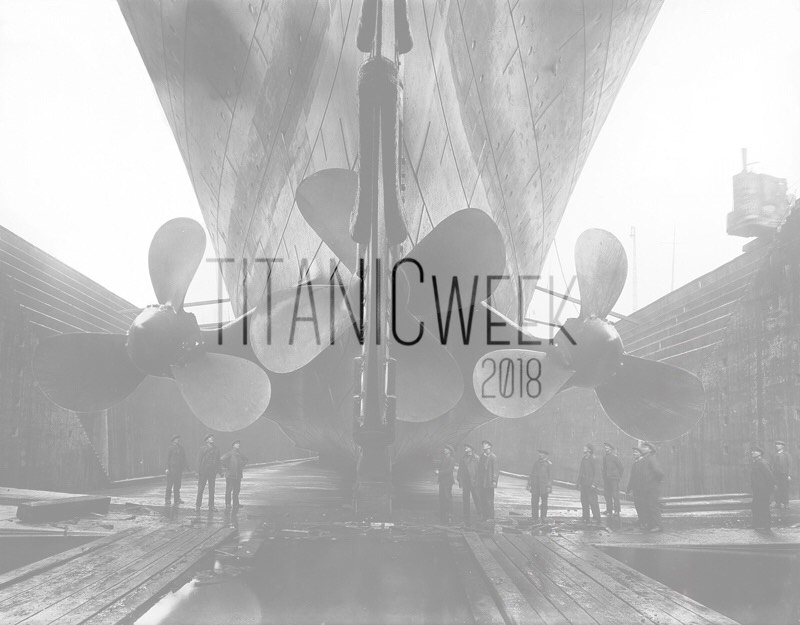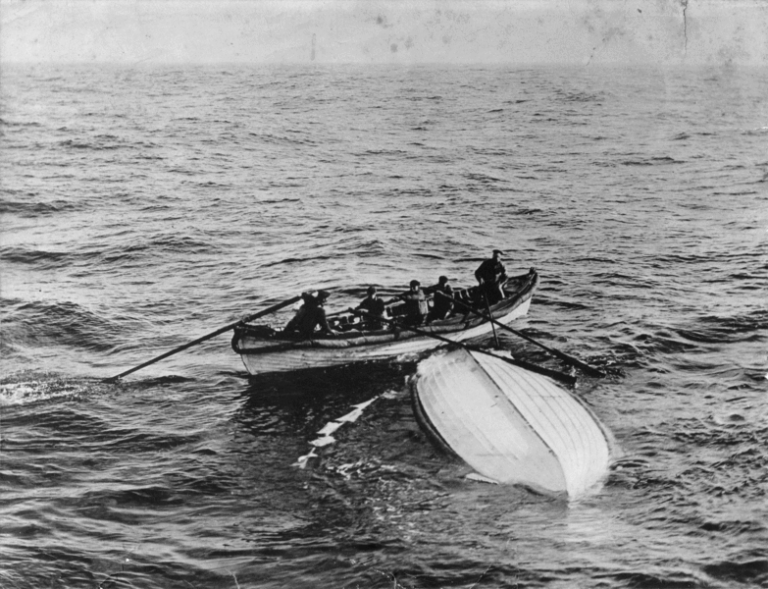"I Am Here for Life": Fifth Officer Harold Lowe
Harold Godfrey Lowe was born in Wales in 1882, the fourth of eight children. At all of 14 years old, he ran away from home to escape an apprenticeship that his father had destined him for.
I ran away from home when I was about 14, and I went in a schooner. I was in seven schooners altogether, and my father wanted to apprentice me but I said I would not be apprenticed; that I was not going to work for anybody for nothing, without any money.
Well, alright then.
Young Harold Lowe endeavored to get his certificates, then worked for about five years off the West African coast before signing on with the White Star Line.
Even though Lowe had been working at sea for some time and had been on two White Star vessels, these voyages were on Australian routes. As such, Titanic was to be his first transatlantic journey.
He signed on as Fifth Officer, and reported to White Star’s Liverpool offices on March 26, 1912. He then went on to Titanic’s sea trials in Belfast.
Being Fifth, Lowe was considered a junior officer, along with Third Officer Herbert Pitman, Fourth Officer Joseph Boxhall, and Sixth Officer James Moody. Unlike his fellow officers, who had all worked together in some capacity before, Lowe was not acquainted with anyone at all.
Lowe was off-duty and in bed on April 14, 1912, when Titanic collided with the iceberg. He stated that he was woken up and informed of it by Fourth Officer Joseph Boxhall about 30 minutes after the fact, although Lowe did not remember this particular moment.
It must have been while I was asleep. You must remember that we do not have any too much sleep and therefore when we sleep we die.
Lowe grabbed his revolver and presented on deck to assist First Officer William Murdoch in launching lifeboats on the starboard side. He insisted that it was calm, for the most part; only “little knots” of people here and there.
When reading Lowe’s testimony, it’s clear that Lowe was a very forthright—even terse—man. And he had precisely no patience for nonsense as he worked to the lower the boats.
Within the event of the sinking itself, nowhere is this more apparent than in a conflict he had with J. Bruce Ismay, the Chairman of White Star.

White Star Chairman J. Bruce Ismay, circa 1912.
It was a very tense point of contention in the Senate Inquiry that would follow the disaster.
Senator SMITH. What did you say to him?
Mr. LOWE. This was on the starboard side. I don't know his name, but I know him by sight. He is a steward. He spoke to me on board the Carpathia. He asked me if I knew what I had said to Mr. Ismay. I said, "I don't know Mr. Ismay. "Well," he said, "you used very, very strong language with him." I said, "Did I?" I said, "I can not help it if I did." He said, "Yes, you did," and he repeated the words. If you wish me to repeat them I will do so; if you do not, I will not.
Senator SMITH. I will first ask you this: What was the occasion for your using this harsh language to Mr. Ismay
Mr. LOWE. The occasion for using the language I did was because Mr. Ismay was overanxious and he was getting a trifle excited. He said, "Lower away! Lower away! Lower away! Lower away!" I said - well, let it be -
Mr. ISMAY. Give us what you said.
Mr. LOWE. The chairman is examining me.
Yeesh.
Lowe went on, at Ismay’s belligerent insistence, to write down and then read out loud the very terrible no-good language he had used.
I told him, "If you will get to hell out of that I shall be able to do something."
…He did not make any reply. I said, "Do you want me to lower away quickly?" I said, "You will have me drown the whole lot of them."
Lowe afterward tried to mitigate, expressing that Ismay was just anxious and trying to help.
While working on Lifeboat 14, Lowe entered into a conversation with Sixth Officer James Moody, and Lowe stated that an officer should accompany the group. Moody deferred to Lowe as the junior-most of the two officers, and insisted that Lowe man the boat, which was about to be lowered away. Moody said he’d take to the next one.
Officer Moody did not survive.
By the time Lifeboat 14 was being lowered, alarm had risen within the crowds. As the vessel descended toward the water, passengers rushed to the edge of the deck, and Lowe fired his pistol three times into the air to ward off some steerage men from jumping down into the boat.
He insisted that his bullets never struck a soul.
Upon reaching the water, Lowe ordered the boat to row approximately 150 yards out from Titanic. He then set to work in corralling four other lifeboats around and lashing them together, to condense the passengers therein and return to the wreck.
Lowe was the only officer to return for survivors.
I herded them together and roped them - made them all tie up - and of course I had to wait until the yells and shrieks had subsided - for the people to thin out - and then I deemed it safe for me to go amongst the wreckage. So I transferred all my passengers - somewhere about 53 passengers - from my boat, and I equally distributed them between my other four boats. Then I asked for volunteers to go with me to the wreck…
Unfortunately, it was done too late. In an effort to avoid the lifeboat being swarmed, they had waited over an hour.
As Lowe maneuvered through the wreckage and corpses, he found only four men alive.
Daylight was breaking by this time, and Lowe perceived the Carpathia steaming ahead in the far distance. He determined then that his lifeboat was fastest, and he rigged the sail. His was the only lifeboat to do so.

Lifeboat 14 (right) approaching the rescue ship Carpathia, with sail up and Fifth Officer Lowe standing. From the George Grantham Bain Collection, courtesy of the library of Congress.
By and by, he came across Collapsible D and took it in tow.
He then discovered Collapsible A in a far worse condition. It had been washed off deck without the canvas sides pulled up, and the few survivors still alive were standing knee-deep in water, including 21-year-old Richard Norris Williams, the young American tennis player destined for fame.
It was also from Collapsible A that Lowe saved to the only woman to be rescued from the water that night: Mrs. Rhoda Abbott, who had lost both her young sons in the sinking.
Lowe also found three corpses within Collapsible A.
As to the three people that I left on her - of course, I may have been a bit hard hearted, I can not say - but I thought to myself, "I am not here to worry about bodies; I am here for life, to save life, and not to bother about bodies," and I left them…
They were dead; yes, sir. The people on the raft told me they had been dead some time. I said, "Are you sure they are dead?" They said, "Absolutely sure." I made certain they were dead, and questioned them one and all before I left this collapsible.
Harold Lowe’s testimony in the subsequent Senate Inquiry was vital—and not a little uncomfortable.
The surviving White Star officers—Lowe, Second Officer Charles Lightoller, Third Officer Herbert Pitman, and Fourth Officer Joseph Boxhall—were of course British citizens, who had been sailing on a British vessel. The men resented being interrogated by the American government, and by men who knew absolutely nothing about seafaring life, to boot.

Titanic's surviving officers, from left to right: Fifith Officer Lowe, Second Officer Charles Lightoller, Fourth Officer Joseph Boxhall; seated: Third Officer Herbert Pitman.
As if that weren’t aggravating enough, the officers were attempting throughout all of this to defend themselves, their dead peers, and their employer. They were livid that these senators, who were ignorant of all maritime terms and protocol, could so easily call their judgments as sailors into question, especially without having suffered the sinking themselves.
And they endured all this in the immediate wake of their own traumas, both physical and mental. Because the Senate Inquiry began a mere four days after Titanic sank, on April 19, 1912.
The reactions of the four surviving officers reflected Britain’s aghast reaction to the American Inquiry in its entirety.
The British press portrayed Senator William Alden Smith of Michigan, who had spearheaded the entire shindig, as a thoroughly ignorant ass. His questioning was misguided and redundant, and often offensive to the witnesses he interviewed.
And to the delight of his countrymen, Harold Lowe let Smith know it, over and again.
"Frequent tilts between Lowe and Smith," a newspaper reported, "enlivened the proceedings."

Illustrations of Senate Inquiry witnesses, inclding Fifth Officer Lowe (lower right). Illustrated by Lous F. Grant for "The Graphic," circa May 1912.
Lowe began his testimony on April 24, 1912.
It got off on the wrong foot, really, when Senator Smith demanded the Lowe sit differently in his chair. Lowe, already vexed at having to testify to begin with, bristled.
The interview hastily degraded as Smith asked inane questions that merited responses from Lowe like, "I could no more tell you now than fly."
Early on in the testimony, Lowe's tone elicited the following from Senator Smith, who clearly found Lowe’s snarky, defensive responses unnecessary. “Let me say this to you, Mr. Lowe: Nobody is on trial here, and this is not a court; this is an inquiry.”
This helped nothing. The two men bickered frequently.
But their most memorable exchange is easily this.
Senator SMITH. Do you know what an iceberg is composed of?
Mr. LOWE. Ice, I suppose, sir.
The room broke with laughter.
And it did again, when Senator Smith asked about the nature of temperature. Lowe is reported to have over-enunciated his already curt reply.
Senator SMITH. What was the temperature between Southampton and the place of the accident?
Mr. LOWE. The temperature, sir?
Senator SMITH. Exactly. Do you know whether it was cold, or whether it was warm? Was it warm when you left Southampton?
Mr. LOWE. Yes; it was nice weather. I should say it would be about 48.
Senator SMITH. Above zero?
Mr. LOWE. Forty-eight degrees.
Senator Smith also interrogated Lowe about his alcohol consumption, even when Lowe professed himself a teetotaler. All because someone whispered to Senator Smith that Lowe might have been drunk that night.
Lowe's father had been an alcoholic, so he took grave offense to this suggestion. Per contemporary reports, he became flushed and was "extremely angry and spoke the words with some heat."
Senator SMITH. Are you a temperate man?
Mr. LOWE. I am, sir. I never touched it in my life. I am an abstainer.
Senator SMITH. I am very glad to have you say that.
Mr. LOWE. I say it, sir, without fear of contradiction.
Senator SMITH. I am not contradicting you, and I congratulate you upon it; but so many stories have been circulated one has just been passed up to me now, from a reputable man, who says it was reported that you were drinking that night.
The whole thing was such a tense affair that Senator Smith reprimanded Lowe on multiple occasions, chiding him for responding with information that he deemed irrelevant—when in truth, Smith's questions were ignorant, confusing, and often, plainly absurd.

A satirical cartoon of Senator William Alden Smith titled "The Importance of Being Earnest" by David Wilson. Illustrated for "The Graphic" in April 1912.
In contrast, audiences found Lowe irreverent and delightful, and he had many favorable reviews.
He even had fangirls. No, really.
But once Lowe had departed, another survivor's testimony put him in a more negative light; she called his language in the lifeboat "blasphemous" and stated that he must have been drunk to be so profane.
People immediately came forward to defend him against the condemnation, including Rhoda Abbott, who said point-blank that if it hadn't been for Lowe, she would have been dead. "It would have been impossible," she said, "for an officer to show more courtesy and many of the criticisms that have been made against this man are very unjust."
Another survivor, Irene Harris, proclaimed him "the real hero of Titanic."
Harold Lowe's reputation went untarnished. The Senate's Sergeant at Arms, Sheriff Joe Bayliss, spoke thusly of him.
I have never prided myself upon being a prophet, but of this I am positive: When the Titanic disaster has become a matter of history, Harold G. Lowe will occupy the hero's place.
© As cited in "Titanic Valour: The Life of Fith Officer Harold Lowe" by Inger Sheil, 2012.
Harold Lowe returned to the mariner life, serving in the Royal Navy Reserve during the First World War and returning to private ships thereafter.
He also volunteered his home as a sector post during the Second World War and served as an Air Raid Warden.
As an ARW, Lowe ensured blackout protocol was observed, soundeded sirens, and generally safeguarded, evacuated, rescued, and sheltered citizens. A job, I think, that Titanic uniquely suited him to perform.
He died in 1944 of hypertension at the age of 61.
SOURCE MATERIAL
Sheil, Inger. "Titanic Valour: The Life of Fifth Officer Harold Lowe." The History Press, 1912.
https://www.encyclopedia-titanica.org/titanic-survivor/harold-godfrey-lowe.html
https://www.titanicinquiry.org/USInq/AmInq05Lowe01.php
http://www.titanicology.com/Titanica/Deposition-HaroldGodfreyLowe.htm
https://en.wikipedia.org/wiki/United_States_Senate_inquiry_into_the_sinking_of_the_RMS_Titanic






















































